The kitchen isn’t just where meals are made; it’s the soul of the home, a space where practicality and beauty meet. One might easily overlook the task of finding the perfect spot to store plates—a seemingly trivial detail with significant consequences. Your choice of storage can deeply influence the flow of your culinary routine and the overall atmosphere of your kitchen. Whether you’re orchestrating your meals in a spacious kitchen or navigating the confines of a cozy apartment, where you store those plates can transform the entire experience.
Why Proper Plate Storage Matters?
In the symphony of kitchen organization, plates often take center stage. They are, after all, used every day, placing them among the most frequently handled items. Poor storage leads to more than mere inconvenience; it breeds frustration, with plates becoming hard to reach, vulnerable to damage. The importance of proper plate storage goes beyond mere convenience—it’s about preserving your dishware. Plates stacked carelessly or stashed in unsuitable spots are destined to chip or crack. An organized kitchen, where every item has its place, does more than just look good; it enhances your cooking experience, making it more enjoyable and efficient.
Assessing Your Kitchen Layout For Optimal Storage
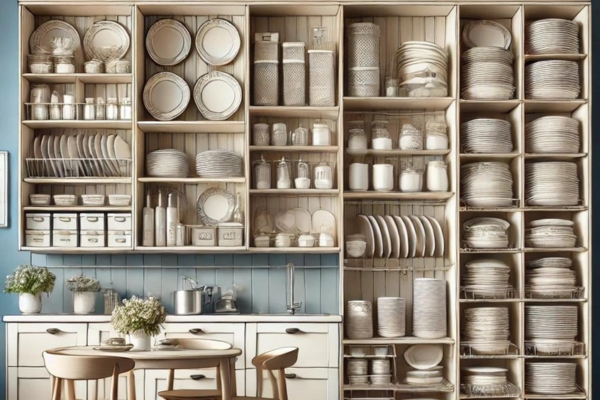
No two kitchens are identical, and this uniqueness extends to their layouts. The kitchen initial step in deciding where to store plates is to evaluate the space available. View your kitchen with a practical eye—where do you usually prepare your meals? Where do you plate your food? Plates should be stored close to these areas to minimize unnecessary movement. Take into account the height of your cabinets, the depth of your shelves, and the ease of accessing drawers. If retrieving your plate feels like an obstacle course, it’s time to reconsider your storage strategy.
The Best Cabinets For Storing Plates In Kitchen

Cabinets are the traditional go-to for plate storage—and rightly so. They offer protection from dust and grease while keeping your dishes neatly out of sight. But not all cabinets are ideal for storing plates. Choose cabinets that are sturdy and deep enough to support your plate without causing them to lean. Upper cabinets are perfect for storing plates you use occasionally, while lower cabinets, especially those close to the dishwasher or sink, are ideal for everyday dishes. If you have a larger collection of plate, consider dedicating an entire cabinet to them, arranging them by size or purpose.
Open Shelving: A Stylish And Functional Choice

For those who lean towards a modern and airy aesthetic, open shelving is both a stylish and functional alternative to closed cabinets. Open shelves not only provide easy access to your plates but also allow you to display your dishware. This option shines particularly in minimalist kitchens, where the beauty of the plate can enhance the overall appeal. However, open shelving has its downsides—exposing your plates to dust and kitchen grime. Thus, it’s best reserved for dishes that are used frequently and washed regularly.
Drawer Storage: Easy Access To Your Plates

Drawers, often underappreciated in kitchen design, can be remarkably effective for storing plates. Deep drawers with peg systems or custom dividers enable you to store plate vertically, making them easy to access without lifting heavy stacks. This storage method is especially beneficial for those with mobility challenges, as it eliminates the need to reach up into high cabinets. Additionally, drawer storage prevents plates from toppling over, reducing the risk of breakage.
Wall-Mounted Racks For Space-Saving Solutions

In kitchens where space is at a premium, wall-mounted racks offer a practical and aesthetically pleasing solution. These racks keep plates within easy reach while freeing up valuable cabinet space. Wall-mounted racks can be installed in various configurations, from simple horizontal bars to more elaborate multi-tiered designs. They are particularly useful in small kitchens, where every inch counts, helping you keep your countertops clear and your kitchen feeling open and uncluttered.
Creative Solutions For Limited Space

Small kitchens demand creativity in storage solutions. If traditional cabinets and shelves aren’t an option, consider using vertical space to your advantage. Over-the-door racks, hanging baskets, and even magnetic strips can be used to store plates in kitchen unconventional yet accessible ways. Another clever approach is to use a dish drying rack as a permanent storage option, placing it on a countertop or within a cabinet. This solution not only saves space but also allows for easy drying and storage in one go.
Utilizing Vertical Space To Store Plates In Kitchen
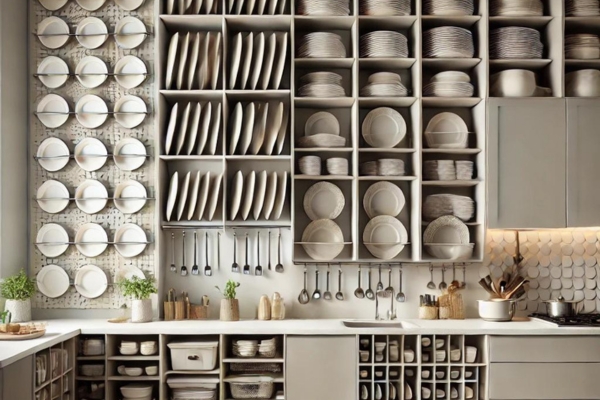
Vertical space is often neglected in kitchen design, yet it holds immense potential for plate storage. Tall cabinets with adjustable shelves can be customized to fit plate of various sizes, while wall-mounted racks and pegboards can hold plates in a vertical orientation. This method not only maximizes storage capacity but also keeps It easily accessible. In particularly tight spaces, consider using a pull-down shelf system, which brings items down to a more convenient height without sacrificing storage space above.
Compact Storage Ideas For Apartment Kitchens

Apartment kitchens often come with the challenge of limited space, but that doesn’t mean you have to sacrifice organization. Compact storage solutions, such as corner cabinets with lazy Susans or tiered shelves within cabinets, can help you make the most of every inch. If floor space is limited, consider wall-mounted options or even storing plates in a nearby dining area. Multi-functional furniture, like kitchen carts or sideboards, can double as storage for plates and other kitchen essentials, making them perfect for small spaces.
Planning Plate Storage During A Kitchen Remodel
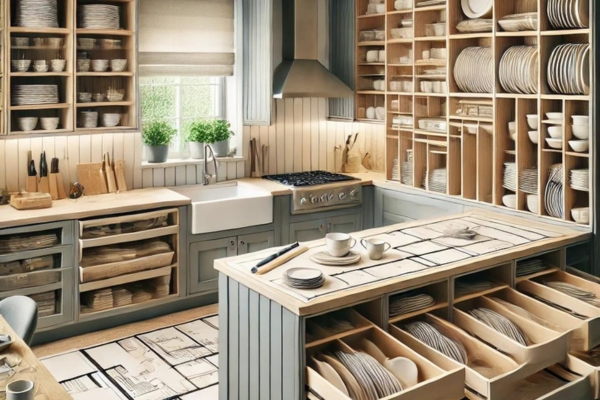
If you’re in the process of remodeling your kitchen, now is the perfect time to think about plate storage. Consider how you use your kitchen and where plate storage fits into your workflow. Custom cabinetry can be designed to accommodate your specific needs, whether that means deeper drawers for plate storage or integrated racks within cabinets. Don’t forget to consider the aesthetics—choose materials and finishes that complement the overall design of your kitchen while ensuring that the storage solutions are functional and easy to maintain.
Integrating Plate Storage Into Kitchen Islands
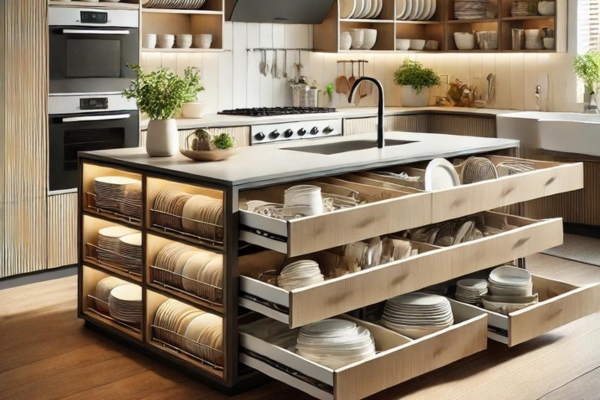
Kitchen islands offer a versatile solution for plate storage, especially in larger kitchens. By integrating storage into the island, you can keep plates close to where they are used most often, whether that’s near the stove for easy plating or by the sink for quick drying and storage. Consider adding deep drawers, open shelves, or even built-in racks to your kitchen island. This not only enhances the functionality of the island but also helps to keep your kitchen organized and clutter-free.
How To Build Your Own Plate Rack
For the DIY enthusiast, building a custom plate rack can be a rewarding project that adds a personal touch to your kitchen. Whether you opt for a simple wall-mounted design or a more elaborate freestanding unit, a DIY It can be tailored to fit your specific needs and space constraints. Choose materials that match your kitchen’s decor, and don’t be afraid to get creative with the design. A well-crafted plate rack can become a focal point in your kitchen, combining both form and function.
Repurposing Furniture For Plate Storage In Kitchen
If you’re looking for a unique and sustainable approach to plate storage, consider repurposing furniture. A vintage hutch, a reclaimed wooden cabinet, or even a sturdy bookshelf can be transformed into a functional and stylish storage solution. Repurposing furniture not only adds character to your kitchen but also allows you to make use of pieces you may already own. With a bit of creativity and some minor modifications, you can create a one-of-a-kind storage option that reflects your personal style.
Using Plate Stands For Display And Storage
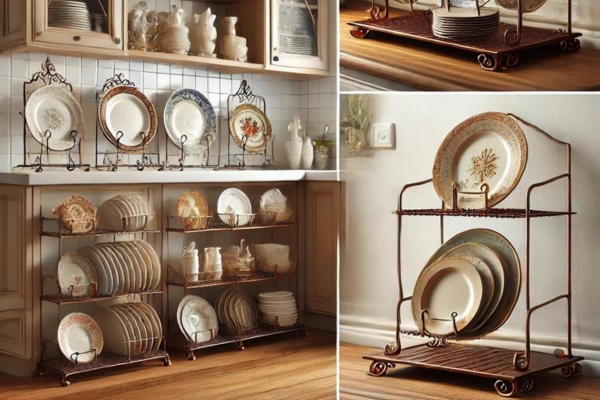
Plate stands offer a dual-purpose solution for those who want to combine storage with display. These stands can be placed on countertops, within cabinets, or on open shelves. Allowing you to showcase your favorite dishes while keeping them easily accessible. Plate stands come in various sizes and styles, from simple wire stands to more ornate wooden or metal designs. They are particularly useful for storing and displaying decorative plates or heirloom dishes that you want to keep on hand but also want to protect.
Storing Plates In Kitchen Cabinets With Dividers
Cabinet dividers are a simple yet effective way to organize plate within your kitchen cabinets. By keeping plates separated by size or type, dividers help prevent them from shifting and becoming damaged. Dividers can be purchased ready-made or custom-built to fit your cabinets. This method of storage is particularly useful for those who have a large collection of plate or who like to keep everyday dishes separate from special occasion ones. Dividers also make it easier to pull out just the plate you need without disturbing the rest.
How To Store Everyday Plates Vs. Special Occasion Plates
Not all plates are created equal, and neither is their storage. Everyday plate, which are used frequently, should be stored in an easily accessible location, such as a lower cabinet or a drawer near the dishwasher. Special occasion plates, on the other hand, can be stored higher up or in a less accessible area, as they are used less frequently. Consider using protective padding or It cases for these dishes to keep them in pristine condition. By storing these two types of plate separately, you can keep your kitchen organized. And make it easier to grab what you need when you need it.
Storing Large Plates Vs. Small Plates Efficiently
When it comes to storing plates of different sizes, efficiency is key. Large plate, such as dinner plates, should be stored in a way that prevents them from tipping over, such as in a deep drawer or with the use of plate dividers. Small It, like salad plates or saucers, can be stacked in smaller cabinets or even on top of larger plates if space is limited. Consider using shelf risers or tiered organizers to maximize vertical space within cabinets. Allowing you to store multiple sizes of plates in the kitchen same area without compromising accessibility.
How To Safely Store Heavy Plates In Kitchen
Heavy plates, such as stoneware or large serving platters, require special consideration when it comes to storage. These items should be stored on sturdy, reinforced shelves or within deep drawers that can support their weight. Avoid stacking heavy plates too high, as this can increase the risk of breakage. If possible, store these It in a lower cabinet to reduce the strain of lifting. Additionally, using protective padding or felt liners between plate can help prevent chipping and scratching.
Childproofing Your Plate Storage Areas
For families with young children, childproofing plate storage areas is essential. Consider storing plates in upper cabinets that are out of reach, or use child safety locks on lower cabinets and drawers. Another option is to store everyday plates in a less accessible area and reserve a lower, more accessible space for child-friendly dishware. Teaching children about the proper handling of plate and involving them in the organization process can also help prevent accidents and keep your kitchen safe.
How To Keep Your Plate Storage Dust-Free
Dust is a persistent problem in any kitchen, especially in open shelving or cabinets that aren’t used frequently. To keep your plate storage areas dust-free, start by ensuring that cabinets and shelves are cleaned regularly. Consider using door seals on cabinets to prevent dust from entering. For open shelves, dust plates frequently or rotate them so that they all get used regularly. Using plate covers or placing plate in protective cases can also help keep them clean while they’re in storage.
Best Practices For Cleaning Plate Racks And Shelves
Regular cleaning of plate racks and shelves is essential to maintain a hygienic kitchen. Start by removing all plate and wiping down the surfaces with a damp cloth or mild cleaner. For stubborn grime or grease, use a mixture of vinegar and water or a specialized kitchen cleaner. Ensure that racks and shelves are completely dry before placing plates back to prevent moisture build-up. Consider lining shelves with easy-to-clean mats or liners to make the cleaning process easier in the future.
Summarizing The Best Ways To Store Plates In Kitchen
Storing plates in the kitchen might seem like a straightforward task, but with the right approach. It can greatly enhance the functionality and aesthetics of your space. Whether you opt for traditional cabinets, modern open shelving, or creative DIY solutions. The key is to find a storage method that suits your kitchen’s layout and your personal needs. By considering factors like accessibility, safety, and cleanliness, you can create a plate storage system that keeps your kitchen organized and your plate in pristine condition.
